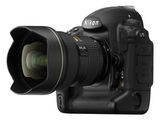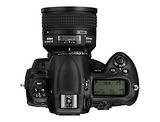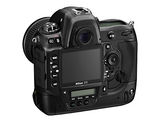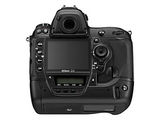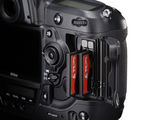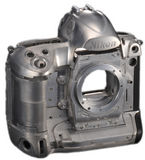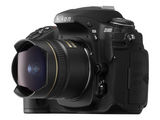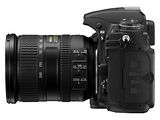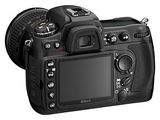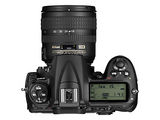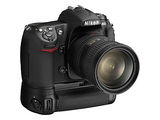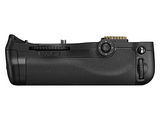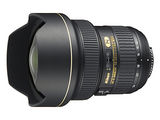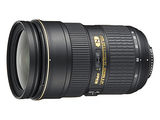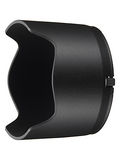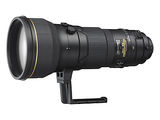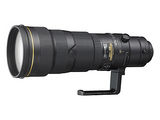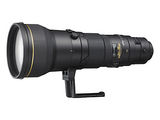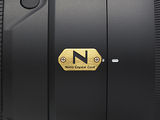Latest News
A Pause For Thought...
Simon Stafford reflects on the recent announcements from Nikon concerning their latest D-SLR cameras, lenses, and software.
As the dust begins to settle after one of the busiest days in the recent history of the Nikon Corporation I thought it might be helpful to pick through the press announcements of 23rd August 2007 and pause to consider some of the highlights, together with some of the less trumpeted features and functions of the D3, D300, new Nikkor lenses, and Nikon software.
The FX-format D3
Unsurprisingly there has been a lot of interest in the new FX-format (23.9 x 35.9 mm), introduced for the first time in a Nikon D-SLR with the D3. Not least because Nikon have achieved a considerable feat of engineering by incorporating a sensor of this size in a camera body that retains the classic Nikon "F" lens mount, to maintain Nikon's longstanding commitment to retrospective compatibility with many earlier Nikkor lenses.
Whenever discussion turns to the relative size of sensor used in a D-SLR the vernacular of modern photographic language is peppered with references to the merits of a "full-frame" sensor but this term (I hesitate to call it a definition) based on the nominal (24 x 36 mm) dimensions of a 35 mm film frame, is an invention spawned from the popularity of the 35mm film camera and photographer's familiarity with the field of view offered by their lenses when shooting on this format. Hence Nikon have chosen to call the format of the new senor, which has been developed in-house with the co-operation of an unnamed partner, the FX-format. The linear dimensions of the image forming area are 23.9 x 35.9 mm. I see three principle benefits in using a sensor of this size:
- Lenses designed for the 35mm 135-format film will offer the same angle of view
- The depth of field of these lenses will be identical to the effect achieved with 35mm film camera bodies
- The larger pixel pitch, the pixels on the FX-format sensor are 8.45 microns square, improves light gather ability, which in turn should help improve the noise performance quality. Nikon have taken the opportunity to completely re-worked the in-camera image processing, now called EXPEED, with a 12-channel output from the sensor supported by an amplifier for each pixel column on the sensor, a new Application Specific Integrated Circuit (ASIC), and user selectable 14-bit depth processing for NEF raw files.
On the matter of the sensor I over heard no less than three people from the gathered ranks of the UK photographic press at the launch event in London, in three separate conversations, attempt to draw comparisons between the pixel count of the D3 (12.1Mp) and the recently announced Canon EOS 1Ds MkIII (21.1Mp) - quite apart from the fact that the pixel count is only one aspect of a camera's potential image quality it should be of some concern to Nikon that the role of the D3, and its position in the Nikon line up, had obviously not sunk in with these individuals. It appears the Nikon marketing team still have work to do!
Nikon make no bones about the fact that the D3 has been designed to meet the requirements of the press and media photographers with its performance bias toward high-speed capture and processing - to this end I expect it to find favour with many wildlife photographers, as well. It was no coincidence that the announcement of the camera occurred together with the announcement of new versions of the 400mm f/2.8, 500mm f/4, and 600mm f/4 lenses, all with the addition of Vibration Reduction II (VR II) and extra AF/manual focus switching options, and two new zoom lenses compatible with both the FX-format and DX-format senor cameras (more on these later).
Nor is it a coincidence that the D3 announcement occurred the day before the opening of the IAAF World Athletics Championship Osaka Games, where it and the new lenses will see their first full, real-world trials. Do not forget that much of Nikon's photographic heritage is based on the success of its professional film camera models, which dominated the world of press and sports photography from the early 1960's through to the mid-1990's, but since then Nikon have played second fiddle to Canon. Nikon want a healthy slice of that market back and the D3 is their solution. If the pixel counters really want to persist then they should at least compare like-with-like (as far as you can) and set the D3 alongside the EOS 1D MkIII (10.1 Mp), although this camera uses an APS-H sized sensor that produces a 1.3x reduction in angle of view, so let the games begin!
The D3 has a couple of other tricks up its sleeve regarding the sensor; at default settings the camera will automatically detect when a DX-format Nikkor lens is attached and apply the in-camera crop to 16 x 24 mm (there is an option to override this feature if you wish), and for any photographer who likes to print to traditional sizes of paper there is a 5:4 ratio crop that reduces the frame area to 24 x 30 mm. In each case a masking system that uses the same liquid polymer system of the D2Xs operates automatically in the viewfinder to define the actual image area, reducing the non-imaging area to a darker and de-focussed view.
Sensor aside Nikon have introduced an awful lot of new features and functions on the D3. The auto focus system has a new 3500-pixel sensor the Multi CAM-3500FX, which provides no less than 51 individual sensing points in a high-density cluster at the centre of the frame area. The central 15 of these sensing areas are cross-types sensitive to detail in both horizontal and vertical orientation. The remaining 36 sensing points, which are all line type areas sensitive to detail orientated in the perpendicular to the sensing area, are split in to two groups of 18, one either side of the 15 cross-type areas. In the DX-crop mode this cluster of 51 AF points fills virtually the full frame. The camera also offers the ability to fine-tune the AF response to individual lenses. The monitor screen is now a huge 3-inch, TFT LCD, with 920,000 pixels that will make assessing image sharpness in-camera a viable process.
In a move inherited from the entry-level D40-series cameras the shooting information can be displayed on the rear monitor screen, in full colour. Plus, Nikon has introduced LiveView, a real-time video output to the monitor screen that enables you to compose the picture without having to use the viewfinder display. The LiveView feature uses a contrast-based auto focus system as opposed to the phase detection system for normal AF operation, and in its "tripod" mode this enable auto focus to be set from any point on the monitor screen, not just the 51 AF sensing areas.
Other new tweaks and twists include:
- A dual CompactFlash card ports that can be set to run concurrently, so you can either create an in-camera back-up as you take pictures, or separate NEF and JPEG files onto different cards, alternative the two cards can be used consecutively to increase shooting capacity.
- The ability to rattle along at 9 frames per second (fps) in the FX-format and up to 11 fps in DX-format: although at the highest rate the AF and auto-exposure systems do not operate between exposures. The shutter unit is tested to 300,000 cycles, twice the limit of any previous professional Nikon SLR camera.
- Nikon's engineers have designed an innovative modification to the tried and tested 1005-pixel RGB metering sensor to create the Scene Recognition System. By adding a diffraction grating in front of the sensor it enables the camera to distinguish a subject's shape and position to help improve both auto exposure and auto focus accuracy.
- A Virtual Horizon Adjustment feature that looks as though it has been lifted straight out of an aircraft's cockpit display will be very useful for photographers that need to shoot pictures with a level camera, such as ensuring straight horizons; however I am not sure it will replace a hot shoe mounted bubble level, the display only accounts for camera tilt to the left or right but offers no assistance when aligning the pitch of the camera up or down.
- The option to save NEF Raw files as uncompressed, or in two states of compression: as compressed (visually lossless, 40-55% compression rates) or losslessly compressed (numerically identical after decompression, 20-40% compression rates).
- The 10-pin remote and PC-sync terminals have the integrated rubber covers from the F6.
- The D3 has a built-in corrective function for the effects of chromatic aberration, so the results from all lenses should show improvement (the same feature is included in the D300).
- A new, separate wireless transmitter, the WT-4/WT4a, which has its own independent power supply for improved performance of both camera and transmitter. By adopting this single, autonomous design the device is also compatible with the D300, and probably future camera models as well.
- Finally, Nikon have thankfully spared us another new battery – the D3 uses the same EN-EL4/EN-EL4a battery, as the D2-series cameras. A new, twin-battery charger the MH-22 will be supplied with the camera; alternatively the current MH-21 charger can be used.
Note: I have prepared a side-by-side comparison of the main specification of the D3 and D2Xs models, which can be found elsewhere on this web site.
Nikon D300
I have to confess to having had a little chuckle to myself at the irony of the way the reaction to the D300 has taken shape - after being asked for more years than I care to remember as to when, or indeed if, Nikon would introduce a D-SLR with a sensor size equivalent to a 35 mm film frame, it is the DX-format D300 that appears to have usurped the FX-format D3 in terms of the level of interest and stolen its thunder!
However, a quick glance at the specification of the new mid-range camera and it soon becomes apparent just how much camera you will be getting for your money. Taking a quick canter round the field of comparison and you end up with the following:
The D300 has a higher frame rate than the D2Xs, and that is before you add the optional MB-D10, matches it on pixel count, is significantly smaller, and lighter, and then overtakes the D2Xs in the areas such as auto focus performance, ISO range, and, putting my faith in Nikon, I expect it to deliver much cleaner images at ISO levels the D2Xs cannot even reach, all at a provisional recommend price that is over a thousand pounds cheaper.
As if that where not enough if you turn to the D3 and draw some more comparisons the D300 stands scrutiny just as well; it shares the same AF system, same EN-EL4a battery for the MB-D10 battery pack, support for UDMA compatible high speed memory cards, 3-inch (diagonal) 920,000 pixel TFT monitor screen, all the new EXPEED functions, including 14-bit analog-to-digital conversion (ADC) with 16-bit image processing, and Live View. None of these are available on the current D200. It can even make use of the new WT-4/WT-4a wireless transmitter, which is compatible with the D3 as well.
In essence Nikon have re-invented the D200 to include everything we all like about it and then given us better than D2Xs performance with virtually all the main features and functions of the D3 and called it the D300 - outstanding!
Note: I have prepared a side-by-side comparison of the main specification of the D300 and D200 models, which can be found elsewhere on this web site.
The New Lenses
AF-S Nikkor 14-24mm f/2.8G ED - this lens will have appeal to certain users but is by no means the universal wide-angle zoom that many might have taken it for initially. Why? Well, you cannot attach ANY filter to it, either at the front where the bulbous front element and fixed metal lens hood protrude, or at the rear where there is no provision for even a slip-in gel filter holder let alone a drop-in filter drawer.
Where this lens will find favour is with the press photographer who needs to shoot under either available light, or with their Speedlight, making full use of that wide, constant maximum aperture of f/2.8. In terms of its size it is remarkably compact being only half as long again as the current AF 14mm f/2.8D lens.
No doubt some will say that software enables the emulation of filter effects and I would not disagree but I always advocate getting this right in camera. Whilst High Dynamic Range (HDR) tools allow scenes with extended contrast ranges to be recorded obviating the need for graduated neutral density filters there will always be the restriction on combining two, or more images using this method where elements within the frame move between consecutive exposures, and some filter effects such as those produced by polariser cannot be achieved in software. Landscape and architecture shooters you have been warned this lens is a polarising filter free zone!
AF-S Nikkor 24-70mm f/2.8G ED - likely to replace the venerable AF-S 28-70mm f/2.8D in time this new lens has a slimmer profile, is slightly lighter but overall length is increased by 12mm (0.5 in). Thankfully, it uses the near standard (for this class of Nikkor optic) 77mm front filter thread, so none of the filtration restrictions of the AF-S 14-24mm apply. The lens has a detachable hood, the HK-40. At 24mm this lens will offer a diagonal angle of view on the FX-format of the D3, or any compatible Nikon film camera, of 84-degrees (61-degrees on the DX-format), which is ten degrees wider than the short end of the AF-S 28-70mm. It has a new, detachable, petal-shape lens hood the HB-40.
The Long Fast Primes
Very, very, welcome although in my opinion long over due, is the outstanding update to the following long fast telephoto lenses: 400mm f/2.8, 500mm f/4, and 600mm f/4. These now complete the line up from the AF-S VR 200mm f/2G through to the longest AF-S VR 600mm f/4G.
Each now incorporates Vibration Reduction (VR) in the form of Nikon's VR II system, Nikon's exclusive Nano Crystal coat that helps to reduce the effects of ghost and flare, and a modified AF/Manual switching mechanism, which is intended to prevent an inadvertent change to manual focus when using auto focus mode.
All three lenses have improved, shorter minimum focus distances shaving a metre off this important specification in each case, which will be music to the ears of wildlife photographers, especially. Plus, in the case of the 400mm f/2.8 and 600mm f/4 lenses there is also a useful reduction in weight. However, a word to the wise, each of the new variants is now a G-type lens, so lacks a conventional aperture ring, so offers limited compatibility with any camera from the F90-series (N90-series), or earlier.
Lenses - what's next?
In short I do not know! I am informed by reliable sources that more lenses are due but Nikon remains coy about what and when. In part delivery of these new optics will depend on the ability to source the necessary raw materials, as the global demand for the constituents of specialized optical glass continues to outstrip supply. To digress briefly this lack of appropriate optical glass has been, in part, the reason for the short supply of the AF-S DX 18-200mm lens.
Assuming that the required materials are available in sufficient quantities it is clear where Nikon should (and hopefully have) been expending their energies in new lens design - short focal length lenses. This is the one area where the current Nikkor line up falls short for both the DX and FX format cameras. Granted the new AF-S 14-24mm lens is a welcome addition but as noted above its inability to accept filters will limit its potential application for some users. Performance of the other stalwart of the wide-angle Zoom-Nikkor range, the AF-S 17-35mm f/2.8D, will not be known until there has been an opportunity to test it with the D3 but it still leaves users of the DX-format cameras with only one option for true wide-angle coverage, the AF-S DX 12-24mm f/4G, with its rather slow f/4 maximum aperture.
I had hoped discontinuation of the AF 28mm f/1.4D lens would herald the announcement of at least a new lens with an equivalent specification but alas it was not to be! For the FX format the Nikkor line up needs wide aperture (f/2 or even f/1.4), prime lenses in focal lengths of 24mm, 28mm, and 35mm. I would also like to see an ultra-wide angle lens to replace the current AF 18mm f/2.8D, which lags behind in terms of optical performance compared with some zoom lenses that offer this focal length. The DX format cameras desperately need similar fixed focal length, wide-aperture lenses, for example a DX 12mm f/2.8 and DX 16mm f/2.
It is interesting to see that Nikon have used the AF 85mm f/1.4D lens in some of the promotional pictures of the D3 but an update to AF-S specification for this and the 50mm version would also be very welcome.
Finally, a very personal plea to the Nikon Corporation: please, please, please introduce a 24mm f/2.8 lens with tilt/shift functions to partner the exquisite Micro-Nikkor PC 85mm f/2.8D! Surely the over-worked excuse that "our market research tells us there is no demand for such a lens" can no longer hold true now the FX-format has been developed.
The Software
Little attention has so far been paid to the other announcements made on 23rd August concerning new software but there are two new applications Nikon Transfer and Nikon View NX, an updated version of Nikon Capture NX, and likewise an update to Camera Control Pro to provide support for the two new cameras.
Of most interest are Nikon Transfer and Nikon View NX, which step in to the void left by the discontinuation of Nikon View 6. Nikon Transfer is a simple utility to provide the initial stepping stone for the transfer of data from memory card to computer allowing the user to added XMP/IPTC metadata at the time of transfer, plus it has the very useful ability to save data simultaneously to separate hard drives enabling the creation of instant back-up copies of your files. It also offers options for the automated renaming and both folders and files at the time of transfer. Nikon View NX provides the browsing, editing, and sorting functions with enhancements to those available previously in Nikon View 6. New features include:
- Colour coded and star ratings that are appended in an XMP file and therefore compatible with Adobe Bridge
- More comprehensive options for key word and file renaming
- New display options that include combined NEF+JPEG, RGB histograms, which AF sensing area was used at the time of the exposure
- Ability to perform conversions of NEF Raw, including application of saved preset values
- Make basic adjustments to NEF Raw file
- Enhancements to features such as automated slideshows and integration of an image file as an e-mail attachment
Apart from adding support for the new cameras the latest iteration of Capture NX, which moves to version 1.3, offers an increased speed of operation, whilst Camera Control Pro 2.0 adds support for the new cameras, an increased speed of operation, and most usefully support for Live View when using a computer to control a D300, or D3, remotely, so it will be possible to preview the composition on the computer's monitor screen.
© Simon Stafford
August 2007
Posted on: Wednesday 29 August 2007


